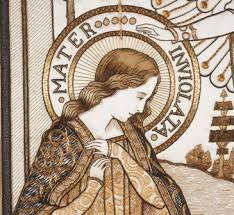“Mary said to the angel, ‘How can this be, since I am a virgin?’ The angel said to her, ‘The Holy Spirit will come upon you, and the power of the Most High will overshadow you; therefore the child to be born will be holy; he will be called Son of God.“ [Luke 1:34-35, NRSV]
[L] An embroidery of the scene of the Annunciation. [M] An embroidery of Mater Inviolata. [R] Mater Inviolata.
Recently, a display of embroidery by the Royal School of Needlework caught our attention. In particular, the very detailed piece of embroidery depicting the scene of the Annunciation captured our interest. It is one of twelve rare embroideries illustrating the Litany of Loreto. They form part of an exhibition of ecclesiastical embroidery, entitled For Worship and Glory, at Hampton Court Palace in southwest London, where the RSN, founded in 1872, is based.
Loreto, in Italy, has been a shrine to Mary since the late 13th century. The Litany of Loreto dates from the Middle Ages. The version of the litany recognised by Pope Sixtus V in 1587 gives 48 titles for the Virgin Mary of which 12 are portrayed in the embroideries. These embroideries, according to the RSN, represent “a strong sense of design” and “worked to a very high standard”. Furthermore, “they show what can be achieved with stylised design and a limited colour palette”.
The embroidery featuring the scene of the Annunciation at once led our attention to a second piece that detained us at length, and that is the piece on Mary as Mother Inviolate [Mater Inviolata].
Save for the title, this embroidery does not bring out any particular distinguishing features about Mary as the Mother Inviolate. But it caused us to pause and recall the diverse arguments on whether Mary remained a perpetual virgin and how one should correctly interpret Scripture that talks about Jesus’ “brothers and sisters” [see Mark 6:3; Matthew 13:55-56]. So-called “critical biblical scholarship” really comes down to which Christian denomination one hails from. Followers of the Catholic, Eastern Orthodox and Oriental Orthodox traditions, as well as some Anglicans and Lutherans, tend to accept the doctrine of the perpetual virginity of Mary and therefore reject the claim that Jesus had blood siblings. Others, Protestants in general, take the literal interpretation and see direct evidence from Scriptures that Jesus had blood siblings. Clearly, the acid that oozed from the sixteenth century Reformation and Counter-Reformation continue to burn and contaminate the very earth that we stand on, much like the millions of litres of defoliants such as Agent Orange the Americans dropped on Vietnam continue to grotesquely maim and harm three decades later today. Writing at a time when the West – largely US and UK, again! – is posturing to strike Syria on claim of Syria’s alleged use of chemical weapons on its own civilians, one cannot but be stunned speechless by how ludicrous the world’s leading politicians can be when US Secretary of State looked straight into the TV camera and called Syria’s alleged use of chemical weapons a “moral obscenity”!
All this recalls for us a lasting impression from the legal practice. There, an inescapable experience of human aptitude points to the fact that judges, influenced as they must be by cultural-political, religious as well as socio-economic reasons, would first make a decision on a high-profile case and then go on to justify it and dress it up nicely by a written judgment. To be sure, a “dissenting judgment” could proceed in quite the same way. In other words, judgments often ran ahead of reasons.
In passing, we would mention the Protoevangelium of James. An important historical document which supports the teaching of Mary’s perpetual virginity, it was written probably less than sixty years after the end of Mary’s earthly life (around A.D. 120), when memories of her life were still vivid in the minds of many. According to the world-renowned patristics scholar, Johannes Quasten: “The principal aim of the whole writing [Protoevangelium of James] is to prove the perpetual and inviolate virginity of Mary before, in, and after the birth of Christ” (Patrology, 1:120–1).
Given all that, we found it immensely more interesting to turn to a different piece of artistic representation of the Mater Inviolata.
Here, we have clear hints of Mary’s title as Mother Inviolate being defined in relation to the sun.
- The sun, in this case, signifies the light which is the deeper metaphorical essence of who Jesus Christ is – the light of the world.
- The relationship between Mary and the sun, symbolizing Jesus Christ, is one of reciprocity: just as the Sun [Jesus Christ] dwells in her virginal person, so also Mary has meaning only in and through the Sun [Jesus Christ].
- In this painting, even the Jesus monogram ISH – Jesus, Saviour, Son – is imprinted on Mary’s chest.
- With Mary occupying a centre-position, there is the hint that her relationship to the Sun [Jesus Christ] is beyond the changing seasons and times as symbolized by the signs of the Zodiac.
- Mary, the inviolate mother, is the mirror without stain (Wisdom 7).
- The light and power of the Holy Spirit traverses her heart and is perfectly reflected because she had kept God’s words in her heart and meditated much [Luke 2:17-19].
- She is inviolately passing on the Spirit’s grace so as to bring light into the world (the burning candle) by virginal birth (virginea generatio).
Copyright © Dr. Jeffrey & Angie Goh, October 2013. All rights reserved.
You are most welcome to respond to this post. Email your comments to us at jeffangiegoh@gmail.com. You can also be dialogue partners in this Ephphatha Coffee-Corner Ministry by sending us questions for discussion.



